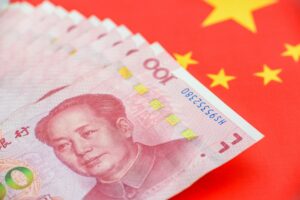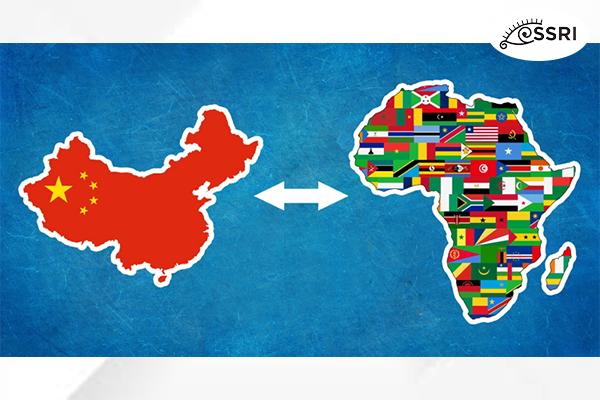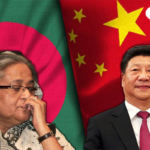In recent decades, China has solidified its position as Africa’s foremost trading partner and primary bilateral lender. Trade has surged to $282.1 billion in 2023, with nations like South Africa, Angola, and the Democratic Republic of Congo emerging as significant exporters to China, while Nigeria stands as its leading importer. However, beneath this economic partnership lie numerous bilateral contracts and treaties that grant China access to Africa’s abundant natural resources and critical infrastructure.

A significant 31% of Africa’s infrastructure contracts now involve Chinese companies, largely driven by China’s ambitious Belt and Road Initiative (BRI). This global infrastructure development strategy aims to revitalize ancient trading routes, including overland routes via the Silk Road and maritime routes through the Maritime Silk Route. Since its launch in 2013, the BRI has financed massive projects, such as railways in Kenya and ports in Djibouti and Nigeria.
Nevertheless, amidst the scale of these initiatives, there are accusations of debt entrapment. Many Chinese-backed infrastructure projects in Africa have faced criticism for their alleged role as debt traps. Critics argue that China structures project-loan terms to ensnare contracting parties in unmanageable debt burdens, leading to reduced concessions or steep economic penalties if borrowers cannot meet their obligations. Furthermore, the enforcement of these agreements often bypasses African courts, resorting instead to gunboat diplomacy and international arbitration.
Decoding Chinese Investment Tactics: Implications for Africa’s Economic Landscape
The strategy of Chinese investment, often labeled as “debt trap diplomacy,” has raised significant concerns, particularly as it intersects with infrastructure projects like the Belt and Road Initiative (BRI). This strategy involves providing loans for infrastructure development while retaining the option to take control of strategic assets if debtor nations struggle with repayment. Former US Secretary of State Rex Tillerson has criticized this approach, arguing that it fosters dependence through opaque contracts, predatory loans, and corrupt practices, ultimately burdening nations with debt and undermining their sovereignty, thus hindering sustainable growth. This multifaceted approach, combined with political and fiscal pressures, casts a shadow over Africa’s rich natural resources and undermines its long-term economic and political stability, leading to a cycle of escalating debt and limited job creation across many countries.
Examples of this phenomenon are evident in grievances expressed by numerous African nations and their citizens. Kenya is a prominent case in point, with criticism mounting over Chinese-funded projects like the Nairobi Expressway. Critics contend that these projects lack transparency, involve high costs, and worsen debt burdens. Of particular concern is the practice of toll collection in dollars, with revenues directed to entities like the China Road Bridge Corporation (CRBC) for extended periods, often spanning decades. The CRBC’s history of involvement in corrupt practices in the Philippines, leading to its World Bank debarment in 2009, adds scrutiny to its operations.
In addition, Kenya’s challenges with repaying debts linked to Chinese-funded construction projects have been exacerbated by Beijing’s reluctance to consider debt deferment requests. Similarly, the Kenya Airport Authority faced pressure to negotiate with China National Aero-Technology International Engineering Corporation in 2021, dealing with demands of approximately USD 38.6 million for terminating a contract related to a terminal’s construction at Jomo Kenyatta International Airport.
By 2023, China has strengthened its control over ports and terminals in nearly 100 locations across more than 50 countries, strategically positioned along critical international waterways. These investments, primarily facilitated by Chinese state-owned entities, establish China as the leading operator of ports crucial to global supply chains. Notably, China’s establishment of a military base near the Chinese-operated port of Djibouti underscores its strategic interests, particularly given its proximity to a United States military base in the same area, hinting at broader geopolitical implications.
Unveiling the Contractual Conundrum: China’s Strategic Maneuvers
China’s approach of deploying substantial development loans through unilateral contracts has often ensnared recipient countries, leveraging its dominant position globally. Alongside geopolitical pressure tactics, the looming threat of international arbitration serves as a coercive tool.
While many contracts between Chinese State-Owned Entities and African nations remain opaque, barring borrowers from disclosing terms or debts, insights into contract structures and practices emerge from public records and studies.
Chinese lending agreements feature distinct commercial clauses designed to favor China. Notably, China’s versions of cross-default clauses enable demanding full repayment upon the borrower’s default to other creditors, especially if actions contradict China’s interests in the borrowing countries. This differs from traditional cross-default clauses, which typically apply to defaults under contracts with the same lender.
China also includes clauses for diplomatic relations termination upon the borrowing party’s default and contract cancellation in response to significant legal or policy changes in the borrower’s country, despite China’s influence in shaping such changes. The reliance on China’s domestic laws, coupled with these contract structures and the threat of gunboat diplomacy, often dissuades countries from pursuing arbitration against China, even with valid claims.
Examples like the Hambantota port case in Sri Lanka serve as cautionary tales, where failure to meet repayment obligations on a loan tied to a Belt and Road Initiative (BRI) project led to a 99-year lease concession of the strategically vital Hambantota port to Chinese entities. While this foreclosure is a standard creditor recourse, geopolitically, it signifies relinquishing control over a crucial national seaport to foreign interests, reflecting a modern form of colonialism through contractual means.
China’s Arbitration Maneuvers: Balancing Investor Rights and Sovereign Immunity
China’s approach to international arbitration, particularly in disputes involving its investors and host states, reveals a complex strategy marked by double standards and legal maneuvers. Although China is a signatory to the Washington Convention on Settlement of Disputes between Investors and Host States (ICSID Convention), granting Chinese investors access to international arbitration through the ICSID Centre in Washington DC without prior local court litigation, it selectively employs this mechanism.
There is anecdotal evidence suggesting that China often prefers arbitration conducted by its own institutions, such as the China International Economic and Trade Arbitration Commission (CIETAC), which has seen a rise in arbitrations involving foreign parties. Despite signing the ICSID Convention in 1991, China has been a respondent in only three cases and a claimant in just two cases, in stark contrast to African states, which have been respondents in over 20 cases. This contrast highlights China’s success in dissuading nations from litigating against its entities, leveraging treaties and contracts that prioritize investor rights over host states’ rights. Additionally, unilateral contract terms and the threat of gunboat diplomacy effectively deter arbitration proceedings against China and its state-owned entities.
Even when arbitration awards go against China, it has shown reluctance to comply, employing various legal tactics to evade liability. Common defenses include invoking absolute state immunity and rejecting enforcement of awards under the New York Convention, citing the “commercial” exception. For example, in a case involving Nigeria, China contested the enforcement of a $55 million arbitral award, using the “commercial” exception in the New York Convention to resist Nigeria’s motion for dismissal.
The South China Sea Arbitration case offers insight into China’s avoidance tactics. Despite the establishment of a UNCLOS tribunal to resolve maritime boundary disputes between China and the Philippines, China chose not to participate. In its final ruling against China, the tribunal deemed many aspects of China’s claims—including the nine-dash line and land reclamation activities in Philippine waters—as illegal. However, China rejected the ruling, refusing to comply and maintaining that it is “null and void” based on national immunity grounds.

Unraveling China’s African Equation: Implications and Imperatives
As China’s economic influence grows in Africa, notably driven by its Belt and Road Initiative (BRI), scrutiny intensifies regarding the nature and consequences of contracts between the parties involved. The looming threat of “debt trap diplomacy,” characterized by secretive agreements, exploitative loans, and the potential seizure of strategic assets, casts a shadow, leaving African nations entangled in mounting debts with limited economic gains.
Equally troubling is China’s selective approach to international arbitration, highlighting its pursuit of commercial and geopolitical dominance. Through confidentiality clauses and customized commercial terms, China maneuvers to leverage its dominant position, undermining the sovereignty and economic well-being of African nations.
The challenge ahead lies in promoting transparency and fostering equitable partnerships that prioritize the long-term interests and development goals of African nations. Only through collective vigilance and concerted efforts to rebalance power dynamics can Africa navigate the complexities of its engagement with China and safeguard its future prosperity and autonomy.
Summary
China’s deepening economic engagement in Africa, driven by initiatives such as the Belt and Road Initiative (BRI), prompts critical inquiries into contractual dynamics and their ramifications. The substantial increase in trade, reaching $282.1 billion in 2023, highlights Africa’s growing dependence on China, particularly in infrastructure development. However, beneath this economic partnership lies a nuanced landscape of bilateral agreements, raising concerns about debt entrapment and biased arbitration practices.
Chinese-backed infrastructure projects, comprising 31% of Africa’s contracts, have faced allegations of trapping nations in unsustainable debt burdens. This purported “debt trap diplomacy” involves opaque contracts and predatory loans, often resulting in limited economic benefits for African countries. Additionally, China’s use of unique arbitration clauses and its selective engagement in international arbitration processes reflect its pursuit of commercial and geopolitical advantages, prompting questions regarding fairness and sovereignty.
Instances such as the Nairobi Expressway project in Kenya illustrate concerns over secrecy and high costs, while China’s strategic control over ports and its reluctance to comply with arbitration rulings, as seen in the South China Sea dispute, compound these worries. Ultimately, Africa grapples with the challenge of balancing economic development with safeguarding autonomy and sovereignty in its interactions with China.
Moving forward, fostering transparency and equitable partnerships is vital to ensuring Africa’s sustainable prosperity and autonomy. Collaborative efforts to address issues of debt sustainability, fair arbitration practices, and balanced contractual terms are essential to navigate the intricacies of China-Africa relations and protect Africa’s economic and political future.
References
- https://www.pmldaily.com/oped/2024/04/the-chinese-trap-in-african-contracts.html
- https://www.iemed.org/publication/the-role-of-china-in-the-middle-east-and-north-africa-mena-beyond-economic-interests/
- https://ieeexplore.ieee.org/abstract/document/10076443
- https://journals.sagepub.com/doi/abs/10.1177/1354068812472553




